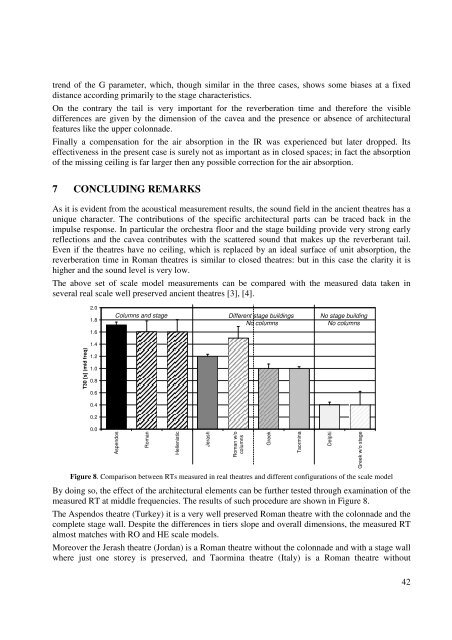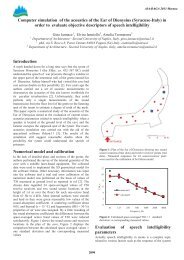ERATO Proceedings Istanbul 2006.pdf - Odeon
ERATO Proceedings Istanbul 2006.pdf - Odeon
ERATO Proceedings Istanbul 2006.pdf - Odeon
You also want an ePaper? Increase the reach of your titles
YUMPU automatically turns print PDFs into web optimized ePapers that Google loves.
trend of the G parameter, which, though similar in the three cases, shows some biases at a fixed<br />
distance according primarily to the stage characteristics.<br />
On the contrary the tail is very important for the reverberation time and therefore the visible<br />
differences are given by the dimension of the cavea and the presence or absence of architectural<br />
features like the upper colonnade.<br />
Finally a compensation for the air absorption in the IR was experienced but later dropped. Its<br />
effectiveness in the present case is surely not as important as in closed spaces; in fact the absorption<br />
of the missing ceiling is far larger then any possible correction for the air absorption.<br />
7 CONCLUDING REMARKS<br />
As it is evident from the acoustical measurement results, the sound field in the ancient theatres has a<br />
unique character. The contributions of the specific architectural parts can be traced back in the<br />
impulse response. In particular the orchestra floor and the stage building provide very strong early<br />
reflections and the cavea contributes with the scattered sound that makes up the reverberant tail.<br />
Even if the theatres have no ceiling, which is replaced by an ideal surface of unit absorption, the<br />
reverberation time in Roman theatres is similar to closed theatres: but in this case the clarity it is<br />
higher and the sound level is very low.<br />
The above set of scale model measurements can be compared with the measured data taken in<br />
several real scale well preserved ancient theatres [3], [4].<br />
2.0<br />
1.8<br />
Columns and stage<br />
building<br />
Different stage buildings<br />
No columns<br />
No stage building<br />
No columns<br />
1.6<br />
1.4<br />
T30 [s] (mid freq)<br />
1.2<br />
1.0<br />
0.8<br />
0.6<br />
0.4<br />
0.2<br />
0.0<br />
Aspendos<br />
Roman<br />
Hellenistic<br />
Jerash<br />
Roman w/o<br />
columns<br />
Greek<br />
Taormina<br />
Delphi<br />
Greek w/o stage<br />
Figure 8. Comparison between RTs measured in real theatres and different configurations of the scale model<br />
By doing so, the effect of the architectural elements can be further tested through examination of the<br />
measured RT at middle frequencies. The results of such procedure are shown in Figure 8.<br />
The Aspendos theatre (Turkey) it is a very well preserved Roman theatre with the colonnade and the<br />
complete stage wall. Despite the differences in tiers slope and overall dimensions, the measured RT<br />
almost matches with RO and HE scale models.<br />
Moreover the Jerash theatre (Jordan) is a Roman theatre without the colonnade and with a stage wall<br />
where just one storey is preserved, and Taormina theatre (Italy) is a Roman theatre without<br />
42
















